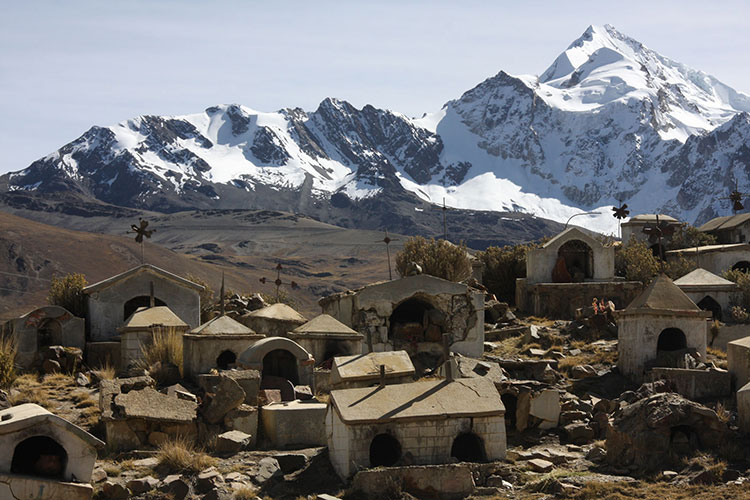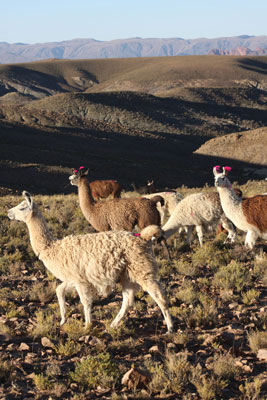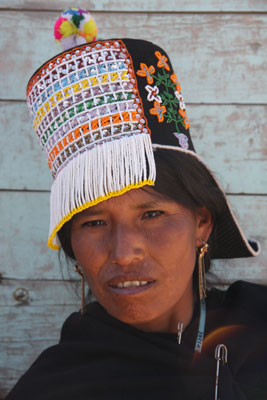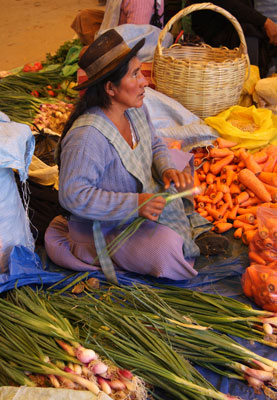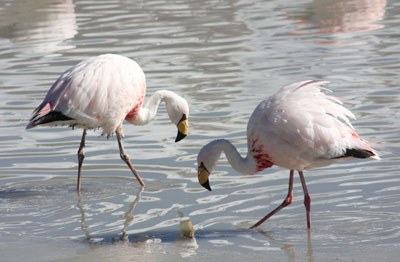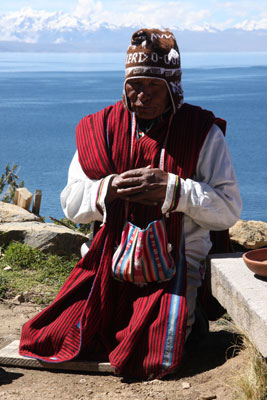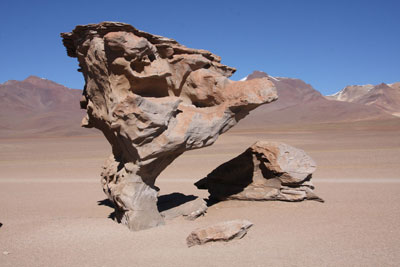From snowcapped mountains to the rainforest, Bolivia is a land of contrasts
This article appears on page 6 of the November 2013 issue.
My wife, Debbie, and I spent 23 glorious days on a privately guided trip through much of Bolivia in 2012. We chose to travel to Bolivia in May in order to capture the best weather in the mountainous region and the Amazon while, in general, avoiding the rainy season (October-March).
Preparations
In planning our trip, we purchased a few different guidebooks on Bolivia. The Lonely Planet guide provided the most practical information for us.
I then wrote to a number of travel agencies — found through the Internet or identified in one of our guidebooks — explaining what we wanted to see, where we wanted to go and the general time frame. I explained our travel interests (which, in a nutshell, revolved around gaining a better understanding of the culture and taking in the scenery) and the type of experience we were looking for, which included staying in the best hotels available, factoring in the relatively low price of accommodations.
I sent a very basic itinerary and asked a number of questions on the logistics of getting from place to place and how much time to devote to each place and expressed our need to have very experienced English-speaking guides and good drivers, given the rough terrain we would be traversing at times.
When we received the responses to our many questions, it became very clear which agency could best represent our interests: Transturin (phone 591 2 242 2222), based in La Paz.
The agent at Transturin with whom we dealt, Rocio Jaen, delivered in every way. She promptly responded to our continuous string of questions as we shaped this somewhat complicated trip, and her input was thorough. She provided background information on the local guides and was very patient and helpful with some changes we made to our itinerary during the course of the trip.
We had originally booked the trip for 2011, but, due to unforeseen circumstances, we had to cancel a month before our planned departure. To show our good faith in doing this trip, I told Rocio that the agency should keep all of the money we had wired to them, as we would do the trip in 2012. She was very understanding, and, as Transturin was able to recoup around 80% of the monies already paid by their agency to various hotels and local agencies, we were charged only for the 20% they lost.
Our trip for two, excluding international airfare, cost $11,308. This price included private guides and drivers for the 23 days, accommodations in the “best available” hotels, daily breakfast, some lunches and dinners (where a meal plan was part of the hotel stay) and internal flights to the Amazon region of Bolivia. We preferred to pay for our own meals in the major towns such as La Paz, Sucre and Potosí, where we had choices for restaurants.
Starting in Sucre
Our trip included visits to La Paz and the colonial cities of Sucre and Potosí; the Altiplano (highlands); Lake Titicaca; Tupiza; the subtropical region of Coroico, and the rainforest. It was an adventure from day one.
We had planned to start our trip in Sucre, flying first into La Paz, but the pilot was unable to make the landing in La Paz due to some problems with the landing gear, so we were diverted to Santa Cruz. We had a very tight, full schedule of activities, so it was important for us to get to Sucre as planned. Fortunately, we were able to catch a connection in Santa Cruz to Sucre the same day (on an airline that went bankrupt three days later).
Sucre is at an elevation of 9,000 feet, but we had no problem adjusting to the altitude. While we took altitude sickness pills with us just in case, since we would reach altitudes of 16,000 feet during the trip, we were able to acclimate simply by not overexerting ourselves and drinking lots of coca tea.
In Sucre we saw an important archaeological site at El Parque Cretácico, a “park” filled with dinosaur footprints dating back 65 million years. We also visited many 17th-century colonial churches.
A UNESCO World Heritage city, Sucre was very clean and very hilly, nestled into a valley surrounded by the foothills of the Andes.
We stayed at Parador Santa Maria La Real, a very charming historical hotel, but we felt that the meals in the restaurants in the area were better than the one meal we had in the parador.
From Sucre we took a day trip to Tarabuco for the Sunday market. The highlight was observing the older people dressed in traditional clothes, the style of which has not changed over the past couple of centuries.
We bought a colorful hat for $45 and a tapestry depicting everyday life. Tapestries like this take several months of work due to the intricacy of the designs. After some bargaining, we purchased it for $160. It is one of our prized purchases from Bolivia, a country filled with handicraft markets and clothing and accessories made of llama or alpaca wool.
We also visited two very basic houses in the countryside, about 30 minutes from Sucre, where we could observe traditional life. The houses were built of straw and mud and had no electricity or running water or TVs or phones.
Of the indigenous cultures of the continent that have preserved their values and customs, the culture of the people of Tarabuco is one of the most ancient.
Potosí
The next day we learned there was going to be a transportation strike in Sucre at 7 a.m., so we left the hotel at 5 a.m. and drove through the dark to Potosí, arriving there around 7:30.
Strikes are not uncommon in Bolivia, and small groups of people can strike for all sorts of reasons. The strikes often take the form of roadblocks, and if a vehicle crosses the stones placed on the road, it’s subject to having rocks thrown at its windows.
While the frequent strikes, which turned into a nationwide strike for about a week while we were there, were somewhat irritating, it was fascinating to observe this phenomenon.
At more than 13,000 feet, Potosí is one of the highest cities in the world. It is also a UNESCO World Heritage Site. We visited a number of its churches and convents and sat in the main square watching a parade of students and accompanying marching bands wearing their school uniforms. It was entertaining and colorful.
We also visited one of Bolivia’s silver mines, Cerro Rico. We were required to wear special pants, boots, jackets and headlamps and had to buy gifts for the miners (such as coca leaves, water, cigarettes, alcohol and dynamite). The entrance to the mine is located at an elevation of 15,000 feet, and it was dark, wet and muddy. Though I am only 5'9", I was quite tall compared to the miners, so I had to constantly crouch low to avoid the wooden beams.
We learned that there are around seven injuries a month in this particular mine and that there had been some deaths of trapped miners recently, but the biggest problem is silicosis, caused by a fine dust that clogs the lungs and often results in death in miners who have worked 10 to 20 years or more. This type of work is passed on from generation to generation, with sons following their fathers into the mine.
After a 5-minute walk into the mine, we made an offering of coca leaves and alcohol to a stone god, wishing the miners safety and luck in finding silver.
Following the mine tour, we attempted to move on to our accommodations for the evening at a hacienda outside of town, but there was a roadblock, so the travel agency changed our reservation to the best hotel inside the town.
Tupiza
Departing at 6 a.m. to avoid more planned roadblocks, we drove to Tupiza. Our guide was surprised to find a blockade on our entry into Tupiza, as it is a more remote city.
Since we had a 4-wheel-drive vehicle for this portion of the trip, we drove through a riverbed that led to a road into town, but we discovered that that road was also blocked. We had to walk our luggage across the blockade, and the guide took us by taxi to our hotel while the driver remained behind with the vehicle. That evening, our driver eventually found a way into town.
Tupiza reminded me of the red rock country in Arizona. We went for a drive into the canyons, which were very beautiful. After a scenic hike, we drove back toward the hotel, but there was another blockade, so we walked across, took a taxi to the hotel, picked up our luggage and walked it back across the blockade to meet our vehicle. We had decided to skip the last scheduled night in Tupiza for fear that we might get stuck there, throwing the rest of our trip off schedule.
The Altiplano
Since we could not take the traditional road to our next destination, San Pablo de Lípez, situated on the Altiplano — the most extensive area of high plateau outside of Tibet — we had to drive through the backcountry on unpaved roads and over riverbeds for 5½ hours, periodically stopping to ask for directions since this was a first for the driver and guide.
While the drive was many hours longer than if we had taken the traditional paved road, we saw some of the most spectacular scenery of our trip, with magnificent views of the canyons.
Since we were in such a remote area, my wife had some anxiety that we might have to sleep in the car overnight, but the driver ploughed on through the dark and we arrived at our next lodge at 8:30 p.m.
We heard that the strikes had spread to La Paz, where the city was almost frozen due to roadblocks and a lack of public transportation. However, for the next week we were in the countryside, away from any cities or villages, and were immune to the strikes that seized many cities throughout the country.
We stayed at Hotel Tayka de los Volcanes for two nights, where we had a large room with stone walls and floor. The shower was heated by solar panels, so it was important to take a shower early in the evening.
During our stay there, we saw packs of llamas and vicunas as well as wild ostriches. At 9 p.m. we accompanied the guide to view the stars. It was like we were in a planetarium! We were hundreds of miles from any industry and pollution, so the stars shined brightly against the pitch-black sky.
The following day we visited the Red Lagoon, surrounded by white-capped mountains and filled with flamingos. There are three types of flamingos that live there, and, while we saw hundreds of flamingos during our visit, our guide noted that in past years there had been up to a couple thousand flamingos inhabiting the lake.
We also visited some fumaroles, with boiling mud and smoke emanating from the small holes in the earth. One had to be careful walking around this area, as there were no rails around the fumaroles.
We passed mountains showcasing many colors and visited Laguna Verde, its emerald-green color a result of high levels of arsenic, sulfur and minerals in the water. The lake was situated right in front of a snowcapped volcano, making for a wonderful “Kodak moment.”
Salar de Uyuni
Following a 20-minute hike through the Valley of the Rocks the next day, we drove on to Salar de Uyuni, the largest aboveground salt flat in the world.
We stayed in Tahua at Hotel Tayka de Sal, almost entirely made of salt. The floor was made of salt crystals, as was the entire bedroom, including the headboard and nightstands. Only the bathroom was more conventional.
The hotel had a wonderful dining room with great meals. (All our meals at the lodges in the Altiplano and at Hotel de Sal were included in our trip cost.)
While in the area, we visited a cave with six mummies dating back 700 years to the Inca period and saw a mummy of a puma in a stone cave. We visited a salt factory and a handicrafts market featuring a number of items made of salt, though they were not of very high quality.
In the middle of the Salar is an island filled with giant cactuses up to 26 feet high — a plant we did not expect to see at that altitude.
Our five very full days of sightseeing in the Altiplano were a major highlight of the trip. Oftentimes we felt like we were at eye level with the snowcaps, and the magnificent scenery, the scarcity of tourists, the wildlife and the isolation all contributed to the thrill of spending time in this region.
La Paz
From the Salar, it was an 8-hour drive to La Paz, excluding a stop in Oruro for lunch and a visit to a couple of mask shops. Oruro hosts a carnival, which is an UNESCO Heritage event, every February, and the masks used are quite colorful.
In La Paz, situated at an altitude of almost 12,000 feet, we stayed at the Casa Grande, a very comfortable upscale hotel located in a fancy neighborhood at the bottom of the valley, where it was more comfortable to breathe. Unlike in most cities around the world, the poorer neighborhoods in La Paz are located higher up on the hills, with the more exclusive areas in the valley.
The following day we took a tour of the city, including the Gold Museum and the Museum of Ethnography & Folklore, both excellent; the cathedral; the Church of San Francisco, considered to be one of the most beautiful churches in Bolivia, with an enormous gilded altar; the Witch Doctors’ Market, a street filled with tourist shops, many containing dried llama fetuses, said to be good for fertility; the Congress buildings; Mirador Killi Killi, with a 360-degree panoramic view of the city, and Moon Valley, where we took a short hike through the lunar-looking landscape with its maze of canyons and pinnacles.
We attended a peña, which is a folkloric show, with dinner, featuring local music and dances from Bolivia. It was very well done.
Since we had long days of sightseeing in La Paz, most evenings we ate in the hotel, where the menu was eclectic, with pastas and pizza and wonderful soups. A complete dinner for two, with appetizers, entrées and desserts, ranged from $20 to $30.
Sun Island
Next we did a 2-day (one-night) excursion to Sun Island, located in Lake Titicaca — at 12,500 feet, one of the highest lakes in the world. Taking a boat to the island, we hiked two hours to our hotel, visiting a small stone Inca temple and passing shepherds and terraced fields with roaming alpacas and donkeys along the way.
We stayed at La Estancia, an ecolodge perched on a hill facing the Royal Range of the Andes. It offered a picture-postcard view of the mountains, which surround much of the lake. For dinner we had trout from the lake and, again, enjoyed a magical view of the stars.
While on the island, we walked through one of the three communities there. Aymara is spoken in this part of Bolivia, in contrast to Quechua, which is spoken in the southern part of the country. We had a wonderful guide, who spoke both Aymara and Quechua as well as Spanish and English.
We visited the primary school and talked to the sixth graders about our home city in the US and about our wonderful experiences in Bolivia. We made a donation to the school, as it was short on supplies and had a number of broken windows.
We then visited the Inti Wata Cultural Complex, owned by Transturin. There we saw a traditional shaman, who performed a ritual blessing over us. We also visited an herbal garden and met a shepherd who very briefly played the flute for us.
In contrast to my visit to Lake Titicaca over 30 years before, we rarely saw reed boats on the lake, and those that did exist were on the Peruvian side and were being used primarily for tourists.
Back in La Paz the following day, we departed for Coroico in the Yungas, an area with semitropical vegetation on the eastern slopes of the Andes.
We traveled for four hours on “Death Road,” once the world’s most dangerous road. Until seven years ago, there were many fatalities because of the road’s hairpin turns and 2-way traffic, but improvements were completed in 2006 in an effort to make the road safer. However, it is still important to be in a vehicle with very good brakes, since the descent on this dirt road can be steep in places and there were no guardrails on the portion we traveled.
We visited a coca farm, where we saw trees with coca beans and different fruits. Throughout Bolivia, one sees people regularly chewing coca leaves. It is a mild stimulant and is effective for digestion and coping with high altitudes.
On an hour’s walk from the hotel on a dirt path, we saw many fruit trees, orchids and other pretty flowers. We then visited some beautiful waterfalls, Las Cascadas, before returning to the hotel for dinner.
Our hotel, El Viejo Molino, was basic but clean and was the best in Coroico. Our room had a view of the lush green countryside.
One of the highlights during our time in the Yungas was a visit to Senda Verde, an animal refuge founded in 2003. We saw six species of monkeys plus parrots, turtles, an ocelot, caimans and an anaconda snake. Because of their exposure to humans, these animals are not released into the wild, but they can roam freely over the extensive grounds and leave at will. However, few animals choose to do so since they are well taken care of, including being fed regularly.
After a 3-hour drive back to La Paz on a mostly paved road, we repacked for our Amazon excursion, leaving most of our luggage at the hotel.
Into the Amazon
The next day we took a 45-minute flight over the Andes to Rurrenabaque in the province of Beni, landing on a very small airstrip in the middle of flat jungle terrain. This is the land of the Tacana people.
We transferred to Hotel Safari, which was clean but very basic.
In the morning we took a motorboat south for an hour on the Beni River, then four hours north on the Tuichi River.
The rainforest was very dense, with a tall canopy. Once we disembarked, it took an hour’s walk through the forest to reach our lodge, Chalalán, located in Madidi National Park. Porters carried our luggage. En route, we saw three species of monkeys and a venomous snake (very well camouflaged on the ground) and heard many birds.
Chalalán was built and is run by the Tacana tribe, which resides in a village three hours farther up the river. The lodge resembles the architecture of the village, with thatch roofs made of palm fronds and mahogany.
All meals were included during our stay. For lunch, we had hearts of palm salad and catfish from the nearby lagoon.
The bathroom was modern, but there was no hot water, so showers were very cold and brief. All beds had mosquito netting, and taking antimalarial medication in this area is a must.
The next day I took three excursions. The first hike was supposed to be four to five hours long, as we viewed medicinal plants, hardwood trees, animal behavior and birds, but after two hours we needed to return to the lodge because it was pouring — no surprise, since we were in the thick of a rainforest. While the guide was very generous in lending me his poncho, I was still soaked from the rain and my shoes and pants were muddy. My wife had been smart to sit this hike out.
In the afternoon the guide accompanied us on a canoe ride to the lagoon for about an hour, then again in the evening. He had an amazing ability to hear and see wildlife and was very good at imitating many animal and bird sounds. Sometimes it was difficult for me to discern if the sounds were from the wildlife or from the guide!
Back at the lodge, we had a cultural evening. A large catfish was caught and cooked in a clay stove with a number of spices and served with different types of vegetables. After dinner, the staff played drums and flutes and performed Tacana dances wearing clay masks. It was very entertaining.
Returning to La Paz
We left the lodge one day earlier than scheduled because of the continuous rain, which did not make hiking particularly fun and seemed to bring out the heartiest of the mosquitoes. Transturin was very helpful in moving up our flight arrangements by a day, one example of many regarding their flexibility in making last-minute changes.
When retaining Transturin, we emphasized our desire for flexibility throughout the trip in terms of how the daily activities would be structured. In exchange for returning to La Paz a day early, we willingly absorbed the cost of an extra night of lodging there since it hadn’t been factored into Transturin’s costs.
On our return to La Paz, we were able to do the river trip in just three hours since we were going with the current, catching a mid-afternoon flight from Rurrenabaque to La Paz.
From La Paz, we did a day trip to Tiwanaku, a 2-hour drive away. Dating from 500 BC to AD1000, preceding the Incas, this is the greatest archaeological ruin of Bolivia. We visited two on-site museums, the remnants of a few temples and a large pyramid temple, spending about 2½ hours there.
On our last day in La Paz, we drove 90 minutes to Chacaltaya. At an altitude of 16,000 feet, it offered breathtaking views of Illimani Mountain and Lake Titicaca.
In all respects, this trip was spectacular, and we were very fortunate to have superb local guides and drivers throughout.
In the colonial cities of Sucre and Potosí, our guide, Lourdes Mendoza, was determined to show us as much of Sucre and Potosí as possible, so we saw many sights beyond those listed on our itinerary. Our guide for Tupiza and the Altiplano, Juan Carlos Gemio, managed to deal with the challenges of the roadblocks to ensure we saw the sights of Tupiza and remained on schedule for our days in the Altiplano.
Our guide in La Paz was Renan and our driver was Jamie, an airline pilot on a 2-year leave. Both guide and driver were superb. We could not imagine driving in La Paz, with its very hilly, winding roads and congested traffic. Jamie was amazing in finding shortcuts to get us efficiently from one site to another. Renan went out of his way to show us the many churches, shops and other sights in La Paz, amounting to very full days.
And we had a superb guide in Chalalán, Alejandro Alvarez, who had 10 years of guiding experience and spoke English well. He was self taught, even though he had grown up in a traditional Tacana community in a location more remote than Chalalán.
For anyone looking for adventure, magnificent scenery, a wide array of wildlife and exposure to a country in South America with a large indigenous population, we heartily recommend Bolivia!

